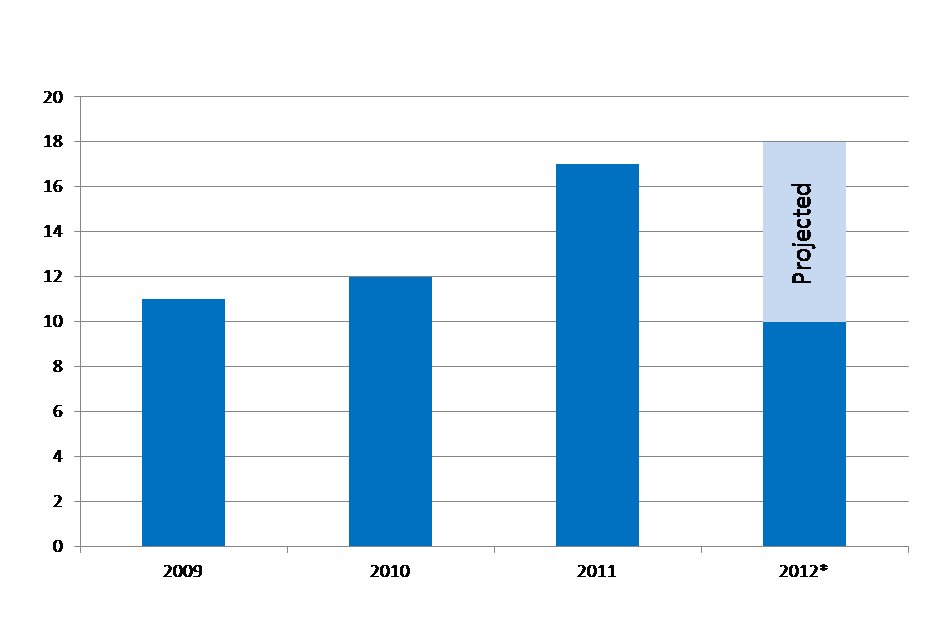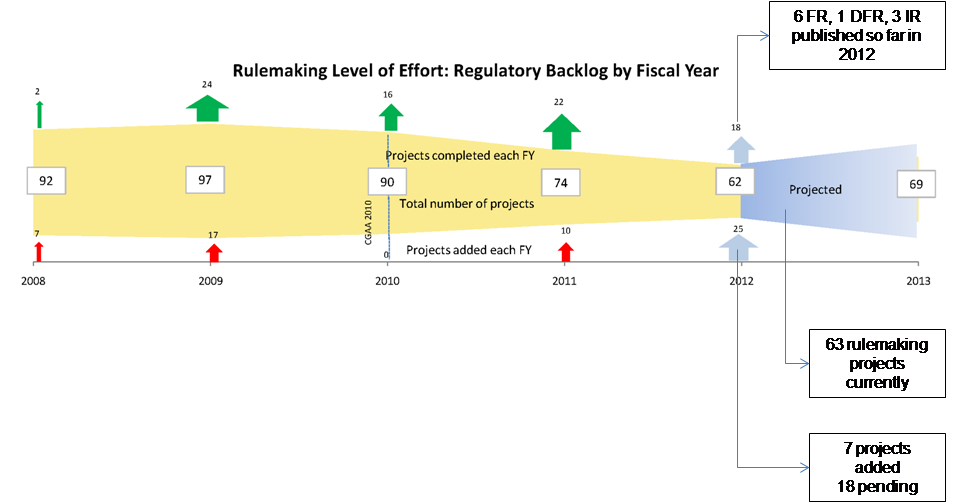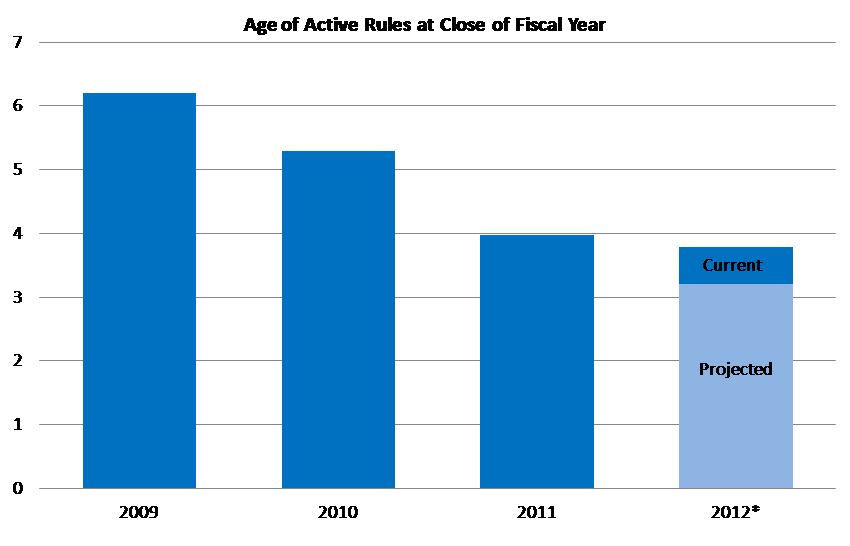2167 Rayburn
Introduction
Good morning Chairman LoBiondo, Ranking Member Larsen, and distinguished members of the subcommittee. It is our pleasure to be here today to discuss the Coast Guard’s regulatory program.
This testimony provides an update to the testimony provided to this subcommittee in May 2011 by RADM Kevin Cook and Mr. Cal Lederer, as well as our annual report and update titled “State of Coast Guard Rulemaking Development.” In that testimony, the Coast Guard described the revised processes used by the Coast Guard to improve the efficiency and effectiveness of rulemaking development, and provided a status report of progress to date. This testimony will provide an update to that status report, but will not replicate the descriptions of those processes, which are largely unchanged.
Beginning with the establishment of the Steamboat Inspection Service, the Coast Guard has been publishing regulations for more than 150 years, with a proven track record of managing maritime risk in a manner for which benefits justify the cost of regulation. The Coast Guard continues to build upon these successes, investing in the workforce, improving process transparency, streamlining processes, and scrutinizing all regulatory actions to ensure the maritime industry operates in a safe, secure, and environmentally sound manner while promoting maritime commerce. The Coast Guard’s Regulatory Development Program has continued its success, earning dividends from program enhancements and a reinvigorated focus on the impacts of regulations allowing for increased emphasis on the requirements set forth in the Coast Guard Authorization Act of 2010 (CGAA 2010).
Coast Guard Regulatory Program
The Coast Guard continues to see positive results from enhanced training, and internal process streamlining and improvements in an effort to meet statutory mandates. Figure 1 shows the increase in rules that have gone into effect and published following Congress’ addition of resources and the Coast Guard’s initiation of major reforms (numbers throughout this report are as of April 9, 2012). These published rules include all Final Rules (FR), Interim Rules (IR), Direct Final Rules (DFR), and Technical Amendments. As shown, the Coast Guard published 17 Final Rules in FY 2011, of which two were statutorily mandated, and ten so far in FY 2012 (dark blue in the graph), of which two were statutorily mandated, with another eight projected by the end of the fiscal year (light blue), of which one is statutorily mandated. Additionally, the Coast Guard publishes approximately 20 Notice of Proposed Rulemakings (NPRM), Advance NPRM, and Supplemental NPRM per year.

Figure 1: Published Rules That Have Gone Into Effect by Fiscal Year
*Indicates projection for 2012
We are proud to report that we have made progress on all currently active regulatory projects in the past year.

Figure 2: Number of Active Rulemaking Projects
With a significant focus on older rulemakings, the average age of rules under development has been reduced from 6.2 years at the end of FY 2009 to approximately four years at the end of FY 2011. This trend is shown in Figure 3. The Coast Guard anticipates further reductions by prioritizing the completion of older rulemaking projects—this is highlighted in the “Projected” portion of Figure 3, which projects an average age of 3.3 years by the end of FY 2012.

Figure 3: Average Age of Active Rulemaking Projects
In addition to working on traditional rulemaking projects, the Coast Guard is also working with DHS to implement the requirements of Executive Order 13563 (“Improving Regulation and Regulatory Review” January 18, 2011). Specifically, the Coast Guard is incorporating the requirements of the Executive Order into its economic analyses. Furthermore, the Coast Guard assisted in the development of the DHS-wide plan for the retrospective review of existing DHS regulations, and identified the four rules shown in Table 1 for detailed study. Each of these retrospective reviews consume rulemaking resources at approximately the same level as a large, significant rulemaking project.
| Rule | Year Published |
|---|---|
| Standards of Training, Certification and Watchkeeping (STCW) | 1997 |
| Facility Security Plans (Maritime Transportation Security Act of 2002) | 2004 |
| Vessel Security Plans (Maritime Transportation Security Act of 2002) | 2004 |
| Revisions to TWIC Requirements | 2007 |
Noteworthy Publications
The Coast Guard’s annual “State of Coast Guard Rulemaking Development” and its update provide a complete list of publications and a list of highlighted projects. Of the publications made since the testimony last year, Table 2 below provides an update.
| Fiscal Year |
Rule (Date Published) | Phase |
|---|---|---|
| 2011 | STCW (August 1, 2011)
|
Supplemental Notice of Proposed Rulemaking |
Towing Vessel Inspection (August 11, 2011)
|
Notice of Proposed Rulemaking |
|
International Anti-Fouling System Certificate (September 1, 2011)
|
Notice of Proposed Rulemaking |
|
| 2012 | International Anti-Fouling System Certificate (December 9, 2011)
|
Final Rule |
Ballast Water Discharge Standard (March 23, 2012)
|
Final Rule | |
Carbon Dioxide Fire Suppression Systems*
|
Final Rule | |
STCW*
|
Final Rule | |
Offshore Supply Vessels > 6,000 GT*
|
Interim Final Rule | |
Transportation Worker Identification Credential (TWIC) Readers*
|
Notice of Proposed Rulemaking |
|
Cruise Vessel Security and Safety Act*
|
Notice of Proposed Rulemaking |
| * Anticipated |
These highlighted rules in Table 2 are illustrative of our rulemaking program, and include Congressional mandates (e.g., International Anti-Fouling System Certificate, which was required in the CGAA 2010), compliance with international conventions (e.g., STCW), and discretionary (e.g., Carbon Dioxide Fire Suppression Systems) rulemakings. The International Anti-Fouling System Certificate rule and the STCW rule enable U.S.-flagged vessels to participate in the international marketplace, demonstrating compliance with international conventions. The Carbon Dioxide Fire Suppression Systems rule provides protection for mariners from release of carbon dioxide and subsequent asphyxiation. A current list of active regulatory projects, for which information is publicly available, is maintained at www.reginfo.gov, and at www.dco.uscg.mil/Our-Organization/Assistant-Commandant-for-Prevention-Policy-CG-5P/Commercial-Regulations-standards-CG-5PS/Office-of-Standards-Evaluation-and-Development/Projects/, which contains links to the Unified Agenda, dockets, and other information sources.
Progress on Statutory Mandates
Of the 81 rules under development, 38 are derived from, or incorporate, statutory mandates. This includes 25 projects either added or modified in response to the CGAA 2010. All 38 of these statutorily mandated projects are underway, cognizant of the deadlines specified by Congress in certain provisions. Eight are at either an Interim Rule or Final Rule stage, close to finalization/effective action. Table 3 lists those 23 rules published in the Fall 2011 Regulatory Agenda that have an associated statutory mandate.
| Title | RIN | Stage |
|---|---|---|
| Claims Procedures Under the Oil Pollution Act of 1990 (USCG-2004-17697) | 1625-AA03 | PreRule |
| Potable Water Standards for Inspected Vessels | 1625-AB51 | PreRule |
| Tonnage Regulations Amendments | 1625-AB74 | PreRule |
| Approval of Classification Societies | 1625-AB35 | Long-term Action |
| Commercial Fishing Industry Vessels | 1625-AA77 | Long-term Action |
| Higher Volume Port Area-State of Washington | 1625-AB75 | Long-term Action |
| State Access to the Oil Spill Liability Trust Fund (USCG-2004-19123) | 1625-AA06 | Long-term Action |
| Discharge-Removal Equipment for Vessels Carrying Oil | 1625-AA02 | Proposed Rule |
| Inspection of Towing Vessels | 1625-AB06 | Proposed Rule |
| MARPOL Annex 1 Update | 1625-AB57 | Proposed Rule |
| Marine Transportation-Related Facility Response Plans for Hazardous Substances | 1625-AA12 | Proposed Rule |
| Numbering of Undocumented Barges | 1625-AA14 | Proposed Rule |
| Outer Continental Shelf Activities | 1625-AA18 | Proposed Rule |
| Tank Vessel Response Plans for Hazardous Substances | 1625-AA13 | Proposed Rule |
| Transportation Worker Identification Credential (TWIC); Card Reader Requirements | 1625-AB21 | Proposed Rule |
| Updates to Maritime Security | 1625-AB38 | Proposed Rule |
| Vessel Documentation User Fees--Annual Renewal Fee | 1625-AB56 | Proposed Rule |
| Great Lakes Pilotage Rates-2012 Annual Review and Adjustment | 1625-AB70 | Final Rule |
| Implementation of the 1995 Amendments to the International Convention on Standards of Training, Certification, and Watchkeeping (STCW) for Seafarers, 1978 | 1625-AA16 | Final Rule |
| Nontank Vessel Response Plans and Other Vessel Response Plan Requirements | 1625-AB27 | Final Rule |
| Offshore Supply Vessels of at Least 6,000 GT ITC | 1625-AB62 | Final Rule |
| Revision to Transportation Worker Identification Credential (TWIC) Requirements for Mariners | 1625-AB80 | Final Rule |
| Vessel Requirements for Notices of Arrival and Departure, and Automatic Identification System | 1625-AA99 | Final Rule |
Conclusion
The Coast Guard continues to work to refine processes and invest in other capabilities to enhance rulemaking development. Efforts continue to focus on analyzing regulatory alternatives so that the benefits of the rules put in place justifies the cost consistent with the requirements of E.O. 13563 and E.O. 12866. The Coast Guard’s strong partnerships with maritime stakeholders ensures that regulatory actions are in the best possible interest of all affected parties, including leveling the playing field for U.S. flag vessel operators competing in a global industry.
Thank you for your continued support and the opportunity to testify before you today. We will be happy to answer any questions you may have.
